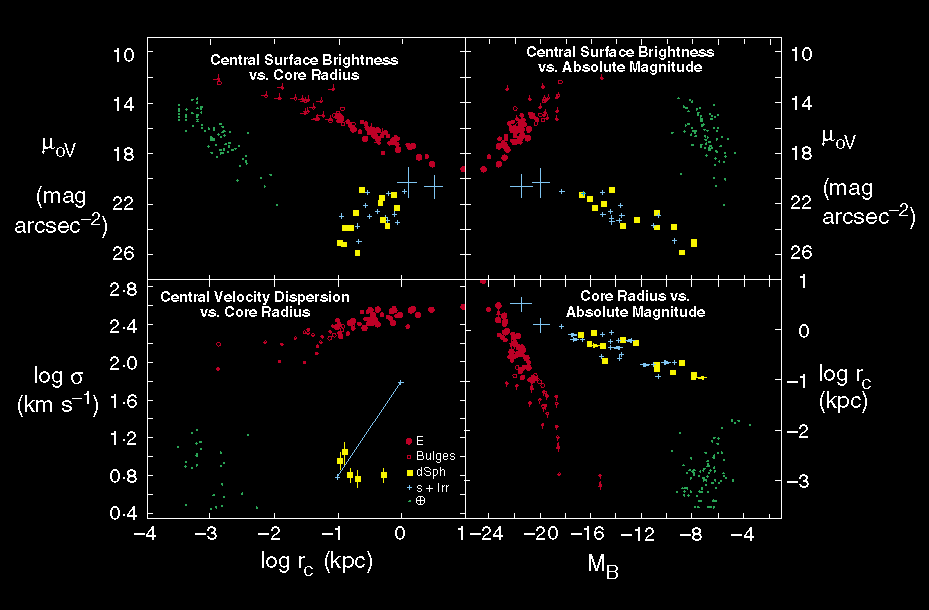

Fundamental plane correlations between seeing-corrected core radius r_c, central surface brightness mu_0V, central velocity dispersion sigma, and bulge absolute magnitude M_B (H_0 = 50 km/s/Mpc) as measured with the Canada-France-Hawaii Telescope (Kormendy 1987). Filled and open circles show elliptical galaxies and bulges of disk galaxies; larger symbols imply better resolution of the core. Squares show spheroidals and plus signs show dwarf spiral and irregular galaxies. The two large crosses are averages for 13 large and 19 small spiral galaxies from Freeman (1970). The small dots are for globular clusters. Click on the plot for a larger version.
ABSTRACT
Kormendy (1985, 1987) showed that bulges and elliptical galaxies, dwarf spheroidal galaxies (dSphs), and globular clusters form three distinct sequences in the core fundamental plane parameter correlations. This suggests that they are three distinct families of ellipsoidal stellar systems with different formation processes. The dSphs, previously thought to be the faint end of the sequence of ellipticals, are physically unrelated to ellipticals. Instead, they have essentially the same parameter correlations as dwarf spiral and irregular (dS+I) galaxies. These results support suggestions that dSphs are dS+I galaxies that have lost their gas or processed it all into stars.
The above results were derived using observed properties of the central parts of galaxies. That they are still valid when we look at global properties is illustrated by the surface brightness profiles of fiducial galaxies along the E, Sph, and dS+I sequences. These galaxies are identified by arrows in the bottom-right panel of the above figure. Their profiles illustrate directly that Es are different from dSphs and that dSphs are similar to dS+Is independent of how characteristic parameters are measured. Binggeli & Cameron (1991) illustrate the differences between the families of ellipsoidal stellar systems using global properties. Early hints that dSphs galaxies are not low-luminosity ellipticals were already seen by Wirth & Gallagher (1984).
Binggeli, B., & Cameron, L. M. 1991, A&A, 252, 27
Freeman, K. C. 1970, ApJ, 160, 811
Kormendy, J. 1985, ApJ, 295, 73
Kormendy, J. 1987, in Nearly Normal Galaxies: From the Planck Time to the
Present, ed. S. M. Faber (New York: Springer-Verlag), 163
Wirth, A., & Gallagher, J. S. 1984, ApJ, 282, 85
University of Texas Astronomy Home Page
John Kormendy (kormendy@astro.as.utexas.edu)